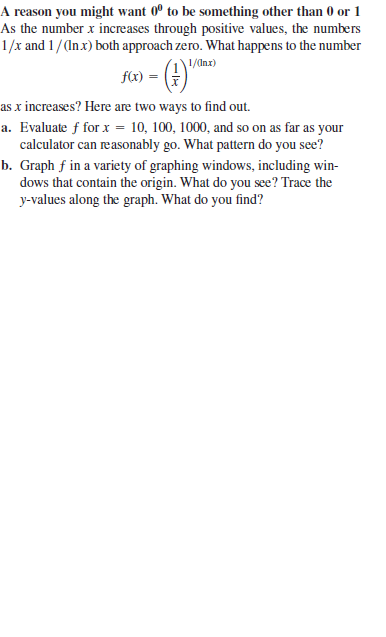A reason you might want 0° to be something other than 0 or 1 As the number x increases through positive values, the numbers 1/x and 1/(In.x) both approach zero. What happens to the number 1/Inx) fx) = (G) as x increases? Here are two ways to find out. a. Evaluate f for x = 10, 100, 1000, and so on as far as your calculator can reasonably go. What pattern do you see? b. Graph f in a variety of graphing windows, including win- dows that contain the origin. What do you see? Trace the y-values along the graph. What do you find?
A reason you might want 0° to be something other than 0 or 1 As the number x increases through positive values, the numbers 1/x and 1/(In.x) both approach zero. What happens to the number 1/Inx) fx) = (G) as x increases? Here are two ways to find out. a. Evaluate f for x = 10, 100, 1000, and so on as far as your calculator can reasonably go. What pattern do you see? b. Graph f in a variety of graphing windows, including win- dows that contain the origin. What do you see? Trace the y-values along the graph. What do you find?
Algebra & Trigonometry with Analytic Geometry
13th Edition
ISBN:9781133382119
Author:Swokowski
Publisher:Swokowski
Chapter6: The Trigonometric Functions
Section6.3: Trigonometric Functions Of Real Numbers
Problem 67E
Related questions
Question
A reason you might want 00 to be something other than 0 or 1 As the number x increases through positive values, the numbers 1>x and 1 > (ln x) both approach zero. What happens to the number

Transcribed Image Text:A reason you might want 0° to be something other than 0 or 1
As the number x increases through positive values, the numbers
1/x and 1/(In.x) both approach zero. What happens to the number
1/Inx)
fx) = (G)
as x increases? Here are two ways to find out.
a. Evaluate f for x = 10, 100, 1000, and so on as far as your
calculator can reasonably go. What pattern do you see?
b. Graph f in a variety of graphing windows, including win-
dows that contain the origin. What do you see? Trace the
y-values along the graph. What do you find?
Expert Solution
Step 1
The given function is .
(a) To Find: values of function for x=10,100,1000,... and find the pattern.
(b) To Plot: the graph of this function and write the observation.
Step 2
The given function is .
At , .
At x=100, .
At x=1000, .
At x=10,000, .
At x=10,0000, .
Here we see that value of the function remain same as we increase x.
So, .
Step by step
Solved in 3 steps with 1 images

Knowledge Booster
Learn more about
Need a deep-dive on the concept behind this application? Look no further. Learn more about this topic, advanced-math and related others by exploring similar questions and additional content below.Recommended textbooks for you

Algebra & Trigonometry with Analytic Geometry
Algebra
ISBN:
9781133382119
Author:
Swokowski
Publisher:
Cengage

Algebra & Trigonometry with Analytic Geometry
Algebra
ISBN:
9781133382119
Author:
Swokowski
Publisher:
Cengage